7HR007: International Human Resources: Domestic vs. International HRM
VerifiedAdded on 2023/01/03
|19
|7340
|38
Essay
AI Summary
This academic paper, focusing on 7HR007, analyzes the contrasting approaches and perspectives of Domestic and International Human Resource Management (HRM). The paper begins by defining HRM and its strategic importance, then delves into a literature review comparing domestic HRM, characterized by its focus on a single nation and culture, with international HRM, which involves managing employees across multiple countries and cultures. The review highlights the complexities of IHRM, including the need for broader perspectives, increased involvement in employee's lives, and the impact of external factors. The paper further examines the recruitment and selection processes, discussing internal and external recruitment sources and their respective merits and demerits. The paper emphasizes the importance of adapting HRM strategies to the global business environment. The analysis underscores the significant differences in the scope, challenges, and strategies of domestic and international HRM, emphasizing the critical role of IHRM in addressing organizational culture and motivating employees in a global context. This paper provides a comprehensive overview of the key differences and considerations within the field of human resource management.
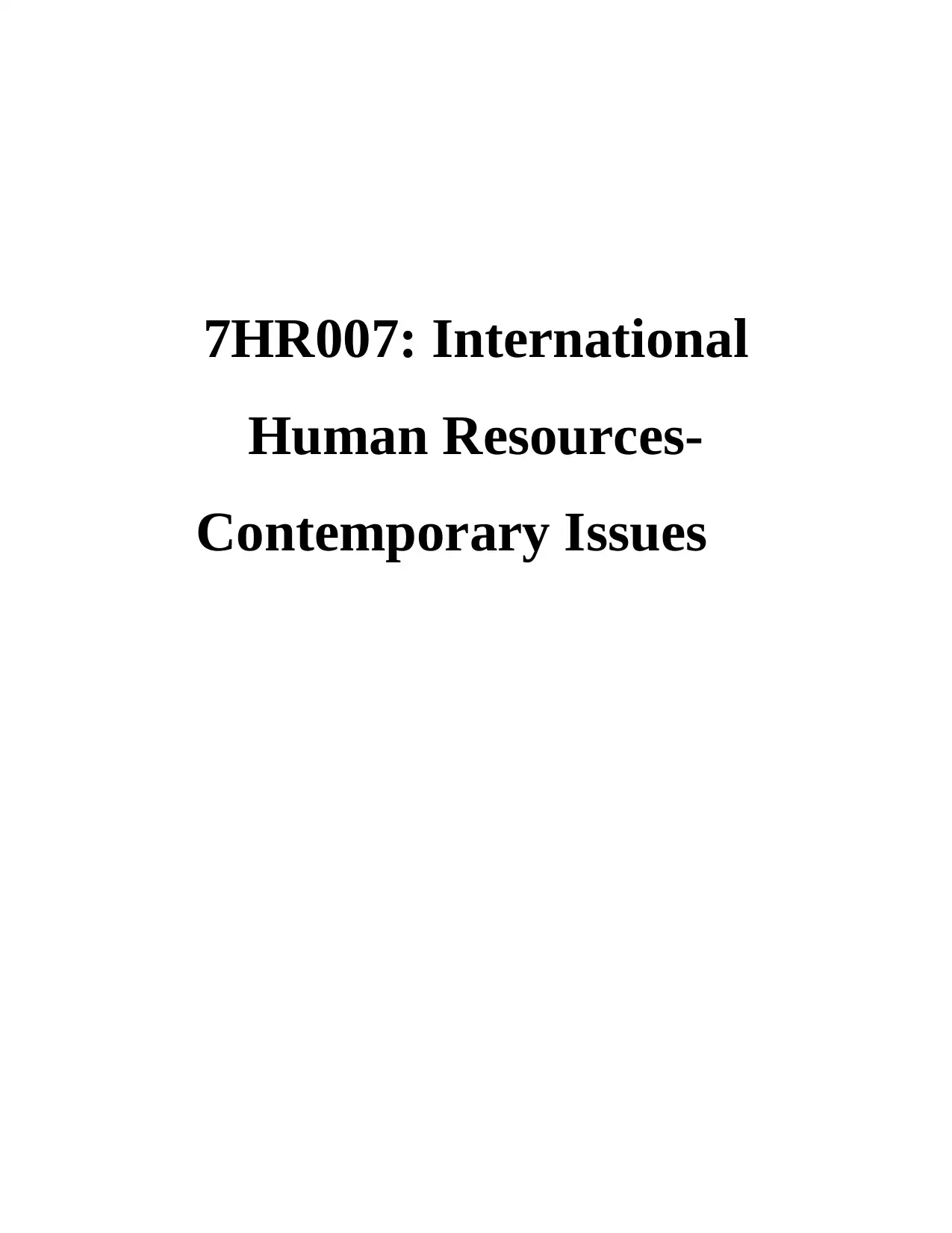
7HR007: International
Human Resources-
Contemporary Issues
Human Resources-
Contemporary Issues
Paraphrase This Document
Need a fresh take? Get an instant paraphrase of this document with our AI Paraphraser
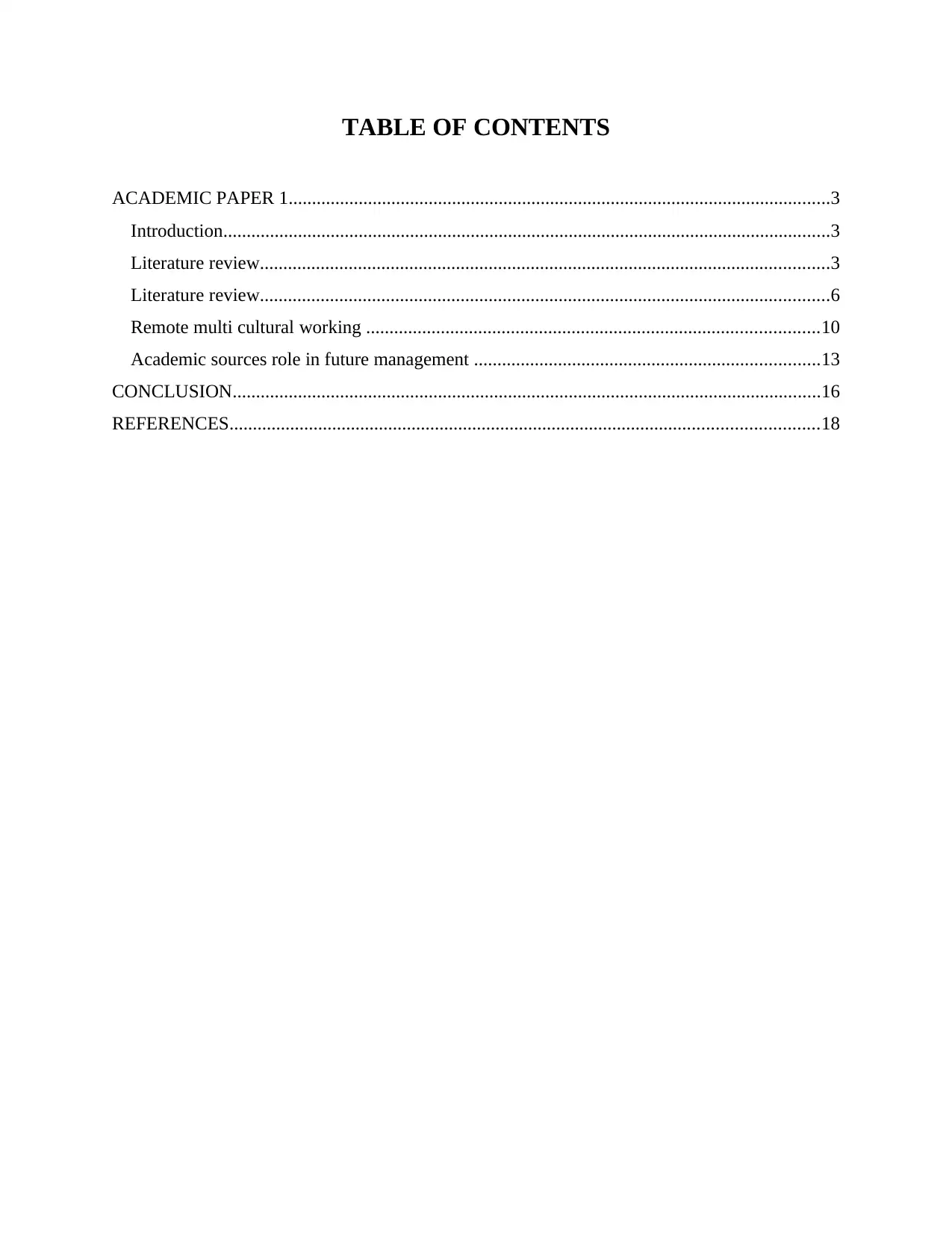
TABLE OF CONTENTS
ACADEMIC PAPER 1....................................................................................................................3
Introduction..................................................................................................................................3
Literature review..........................................................................................................................3
Literature review..........................................................................................................................6
Remote multi cultural working .................................................................................................10
Academic sources role in future management ..........................................................................13
CONCLUSION..............................................................................................................................16
REFERENCES..............................................................................................................................18
ACADEMIC PAPER 1....................................................................................................................3
Introduction..................................................................................................................................3
Literature review..........................................................................................................................3
Literature review..........................................................................................................................6
Remote multi cultural working .................................................................................................10
Academic sources role in future management ..........................................................................13
CONCLUSION..............................................................................................................................16
REFERENCES..............................................................................................................................18
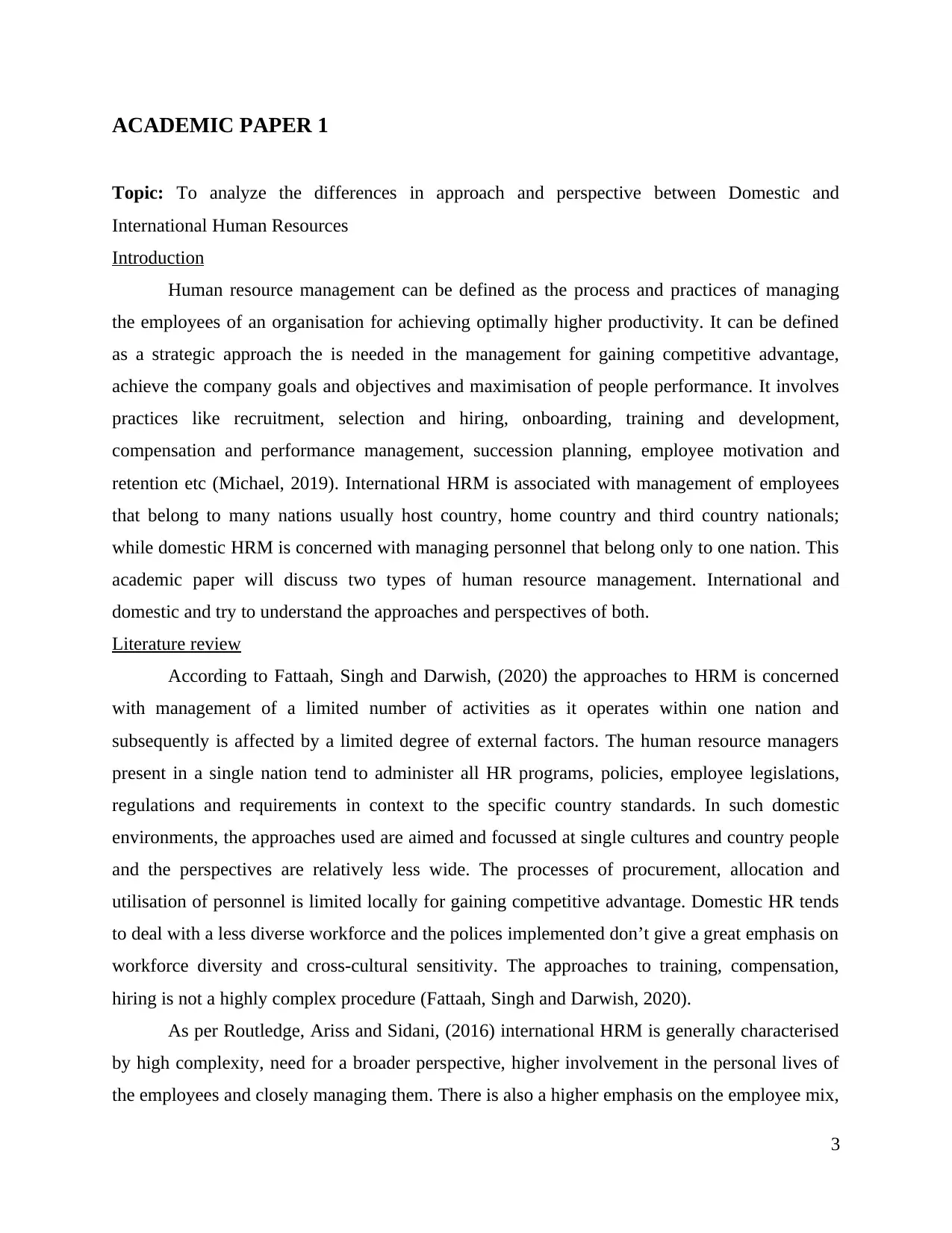
ACADEMIC PAPER 1
Topic: To analyze the differences in approach and perspective between Domestic and
International Human Resources
Introduction
Human resource management can be defined as the process and practices of managing
the employees of an organisation for achieving optimally higher productivity. It can be defined
as a strategic approach the is needed in the management for gaining competitive advantage,
achieve the company goals and objectives and maximisation of people performance. It involves
practices like recruitment, selection and hiring, onboarding, training and development,
compensation and performance management, succession planning, employee motivation and
retention etc (Michael, 2019). International HRM is associated with management of employees
that belong to many nations usually host country, home country and third country nationals;
while domestic HRM is concerned with managing personnel that belong only to one nation. This
academic paper will discuss two types of human resource management. International and
domestic and try to understand the approaches and perspectives of both.
Literature review
According to Fattaah, Singh and Darwish, (2020) the approaches to HRM is concerned
with management of a limited number of activities as it operates within one nation and
subsequently is affected by a limited degree of external factors. The human resource managers
present in a single nation tend to administer all HR programs, policies, employee legislations,
regulations and requirements in context to the specific country standards. In such domestic
environments, the approaches used are aimed and focussed at single cultures and country people
and the perspectives are relatively less wide. The processes of procurement, allocation and
utilisation of personnel is limited locally for gaining competitive advantage. Domestic HR tends
to deal with a less diverse workforce and the polices implemented don’t give a great emphasis on
workforce diversity and cross-cultural sensitivity. The approaches to training, compensation,
hiring is not a highly complex procedure (Fattaah, Singh and Darwish, 2020).
As per Routledge, Ariss and Sidani, (2016) international HRM is generally characterised
by high complexity, need for a broader perspective, higher involvement in the personal lives of
the employees and closely managing them. There is also a higher emphasis on the employee mix,
3
Topic: To analyze the differences in approach and perspective between Domestic and
International Human Resources
Introduction
Human resource management can be defined as the process and practices of managing
the employees of an organisation for achieving optimally higher productivity. It can be defined
as a strategic approach the is needed in the management for gaining competitive advantage,
achieve the company goals and objectives and maximisation of people performance. It involves
practices like recruitment, selection and hiring, onboarding, training and development,
compensation and performance management, succession planning, employee motivation and
retention etc (Michael, 2019). International HRM is associated with management of employees
that belong to many nations usually host country, home country and third country nationals;
while domestic HRM is concerned with managing personnel that belong only to one nation. This
academic paper will discuss two types of human resource management. International and
domestic and try to understand the approaches and perspectives of both.
Literature review
According to Fattaah, Singh and Darwish, (2020) the approaches to HRM is concerned
with management of a limited number of activities as it operates within one nation and
subsequently is affected by a limited degree of external factors. The human resource managers
present in a single nation tend to administer all HR programs, policies, employee legislations,
regulations and requirements in context to the specific country standards. In such domestic
environments, the approaches used are aimed and focussed at single cultures and country people
and the perspectives are relatively less wide. The processes of procurement, allocation and
utilisation of personnel is limited locally for gaining competitive advantage. Domestic HR tends
to deal with a less diverse workforce and the polices implemented don’t give a great emphasis on
workforce diversity and cross-cultural sensitivity. The approaches to training, compensation,
hiring is not a highly complex procedure (Fattaah, Singh and Darwish, 2020).
As per Routledge, Ariss and Sidani, (2016) international HRM is generally characterised
by high complexity, need for a broader perspective, higher involvement in the personal lives of
the employees and closely managing them. There is also a higher emphasis on the employee mix,
3
⊘ This is a preview!⊘
Do you want full access?
Subscribe today to unlock all pages.

Trusted by 1+ million students worldwide
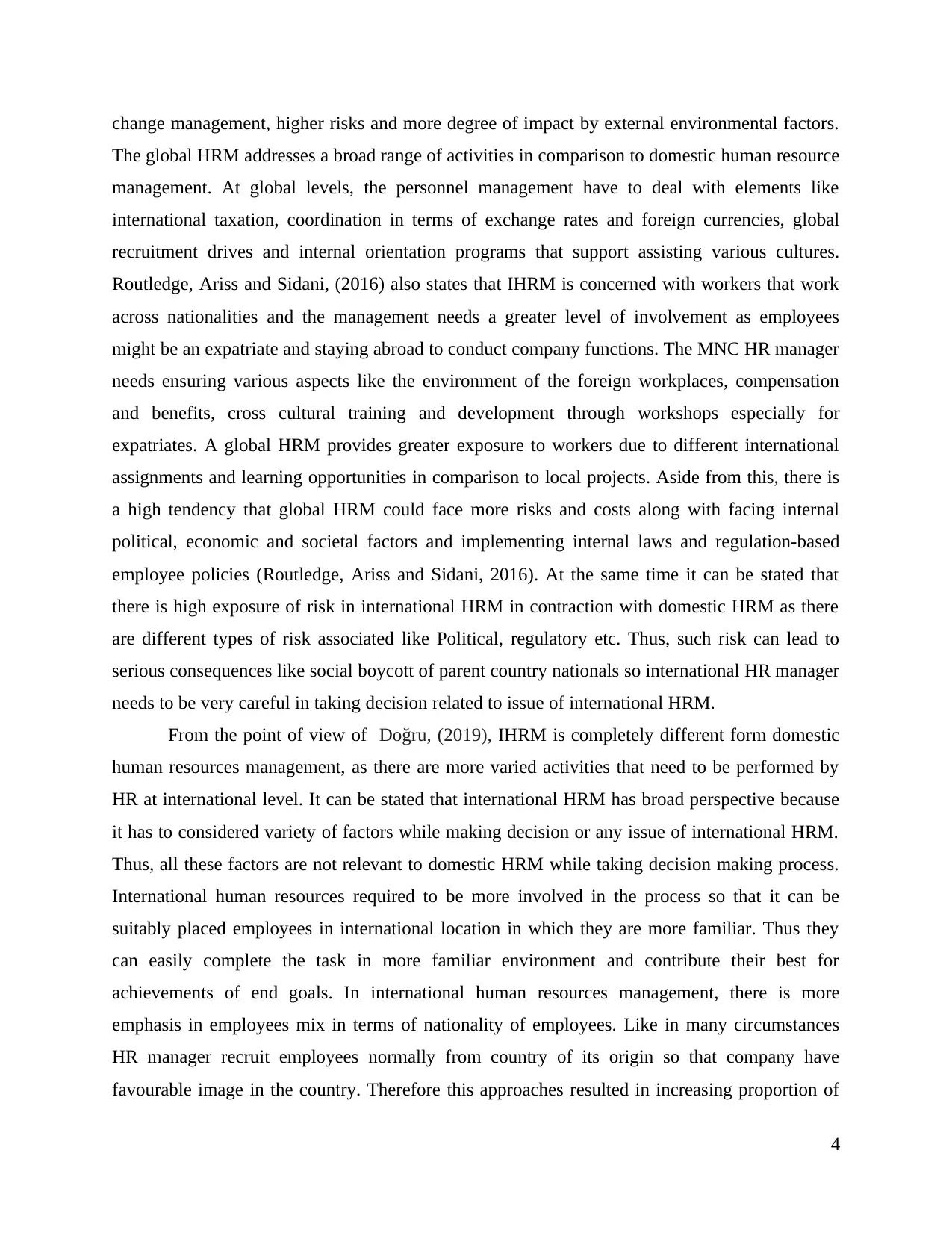
change management, higher risks and more degree of impact by external environmental factors.
The global HRM addresses a broad range of activities in comparison to domestic human resource
management. At global levels, the personnel management have to deal with elements like
international taxation, coordination in terms of exchange rates and foreign currencies, global
recruitment drives and internal orientation programs that support assisting various cultures.
Routledge, Ariss and Sidani, (2016) also states that IHRM is concerned with workers that work
across nationalities and the management needs a greater level of involvement as employees
might be an expatriate and staying abroad to conduct company functions. The MNC HR manager
needs ensuring various aspects like the environment of the foreign workplaces, compensation
and benefits, cross cultural training and development through workshops especially for
expatriates. A global HRM provides greater exposure to workers due to different international
assignments and learning opportunities in comparison to local projects. Aside from this, there is
a high tendency that global HRM could face more risks and costs along with facing internal
political, economic and societal factors and implementing internal laws and regulation-based
employee policies (Routledge, Ariss and Sidani, 2016). At the same time it can be stated that
there is high exposure of risk in international HRM in contraction with domestic HRM as there
are different types of risk associated like Political, regulatory etc. Thus, such risk can lead to
serious consequences like social boycott of parent country nationals so international HR manager
needs to be very careful in taking decision related to issue of international HRM.
From the point of view of Doğru, (2019), IHRM is completely different form domestic
human resources management, as there are more varied activities that need to be performed by
HR at international level. It can be stated that international HRM has broad perspective because
it has to considered variety of factors while making decision or any issue of international HRM.
Thus, all these factors are not relevant to domestic HRM while taking decision making process.
International human resources required to be more involved in the process so that it can be
suitably placed employees in international location in which they are more familiar. Thus they
can easily complete the task in more familiar environment and contribute their best for
achievements of end goals. In international human resources management, there is more
emphasis in employees mix in terms of nationality of employees. Like in many circumstances
HR manager recruit employees normally from country of its origin so that company have
favourable image in the country. Therefore this approaches resulted in increasing proportion of
4
The global HRM addresses a broad range of activities in comparison to domestic human resource
management. At global levels, the personnel management have to deal with elements like
international taxation, coordination in terms of exchange rates and foreign currencies, global
recruitment drives and internal orientation programs that support assisting various cultures.
Routledge, Ariss and Sidani, (2016) also states that IHRM is concerned with workers that work
across nationalities and the management needs a greater level of involvement as employees
might be an expatriate and staying abroad to conduct company functions. The MNC HR manager
needs ensuring various aspects like the environment of the foreign workplaces, compensation
and benefits, cross cultural training and development through workshops especially for
expatriates. A global HRM provides greater exposure to workers due to different international
assignments and learning opportunities in comparison to local projects. Aside from this, there is
a high tendency that global HRM could face more risks and costs along with facing internal
political, economic and societal factors and implementing internal laws and regulation-based
employee policies (Routledge, Ariss and Sidani, 2016). At the same time it can be stated that
there is high exposure of risk in international HRM in contraction with domestic HRM as there
are different types of risk associated like Political, regulatory etc. Thus, such risk can lead to
serious consequences like social boycott of parent country nationals so international HR manager
needs to be very careful in taking decision related to issue of international HRM.
From the point of view of Doğru, (2019), IHRM is completely different form domestic
human resources management, as there are more varied activities that need to be performed by
HR at international level. It can be stated that international HRM has broad perspective because
it has to considered variety of factors while making decision or any issue of international HRM.
Thus, all these factors are not relevant to domestic HRM while taking decision making process.
International human resources required to be more involved in the process so that it can be
suitably placed employees in international location in which they are more familiar. Thus they
can easily complete the task in more familiar environment and contribute their best for
achievements of end goals. In international human resources management, there is more
emphasis in employees mix in terms of nationality of employees. Like in many circumstances
HR manager recruit employees normally from country of its origin so that company have
favourable image in the country. Therefore this approaches resulted in increasing proportion of
4
Paraphrase This Document
Need a fresh take? Get an instant paraphrase of this document with our AI Paraphraser
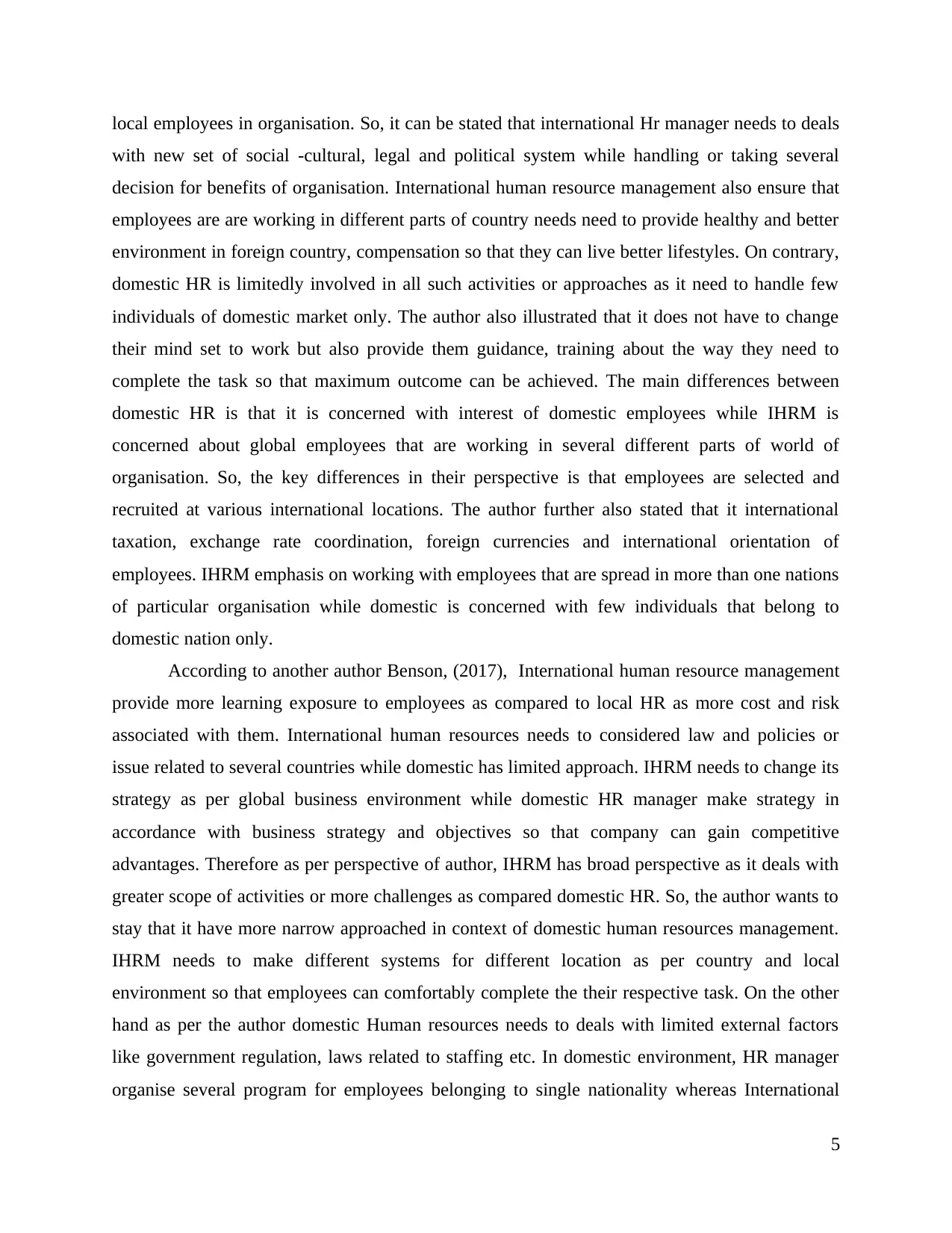
local employees in organisation. So, it can be stated that international Hr manager needs to deals
with new set of social -cultural, legal and political system while handling or taking several
decision for benefits of organisation. International human resource management also ensure that
employees are are working in different parts of country needs need to provide healthy and better
environment in foreign country, compensation so that they can live better lifestyles. On contrary,
domestic HR is limitedly involved in all such activities or approaches as it need to handle few
individuals of domestic market only. The author also illustrated that it does not have to change
their mind set to work but also provide them guidance, training about the way they need to
complete the task so that maximum outcome can be achieved. The main differences between
domestic HR is that it is concerned with interest of domestic employees while IHRM is
concerned about global employees that are working in several different parts of world of
organisation. So, the key differences in their perspective is that employees are selected and
recruited at various international locations. The author further also stated that it international
taxation, exchange rate coordination, foreign currencies and international orientation of
employees. IHRM emphasis on working with employees that are spread in more than one nations
of particular organisation while domestic is concerned with few individuals that belong to
domestic nation only.
According to another author Benson, (2017), International human resource management
provide more learning exposure to employees as compared to local HR as more cost and risk
associated with them. International human resources needs to considered law and policies or
issue related to several countries while domestic has limited approach. IHRM needs to change its
strategy as per global business environment while domestic HR manager make strategy in
accordance with business strategy and objectives so that company can gain competitive
advantages. Therefore as per perspective of author, IHRM has broad perspective as it deals with
greater scope of activities or more challenges as compared domestic HR. So, the author wants to
stay that it have more narrow approached in context of domestic human resources management.
IHRM needs to make different systems for different location as per country and local
environment so that employees can comfortably complete the their respective task. On the other
hand as per the author domestic Human resources needs to deals with limited external factors
like government regulation, laws related to staffing etc. In domestic environment, HR manager
organise several program for employees belonging to single nationality whereas International
5
with new set of social -cultural, legal and political system while handling or taking several
decision for benefits of organisation. International human resource management also ensure that
employees are are working in different parts of country needs need to provide healthy and better
environment in foreign country, compensation so that they can live better lifestyles. On contrary,
domestic HR is limitedly involved in all such activities or approaches as it need to handle few
individuals of domestic market only. The author also illustrated that it does not have to change
their mind set to work but also provide them guidance, training about the way they need to
complete the task so that maximum outcome can be achieved. The main differences between
domestic HR is that it is concerned with interest of domestic employees while IHRM is
concerned about global employees that are working in several different parts of world of
organisation. So, the key differences in their perspective is that employees are selected and
recruited at various international locations. The author further also stated that it international
taxation, exchange rate coordination, foreign currencies and international orientation of
employees. IHRM emphasis on working with employees that are spread in more than one nations
of particular organisation while domestic is concerned with few individuals that belong to
domestic nation only.
According to another author Benson, (2017), International human resource management
provide more learning exposure to employees as compared to local HR as more cost and risk
associated with them. International human resources needs to considered law and policies or
issue related to several countries while domestic has limited approach. IHRM needs to change its
strategy as per global business environment while domestic HR manager make strategy in
accordance with business strategy and objectives so that company can gain competitive
advantages. Therefore as per perspective of author, IHRM has broad perspective as it deals with
greater scope of activities or more challenges as compared domestic HR. So, the author wants to
stay that it have more narrow approached in context of domestic human resources management.
IHRM needs to make different systems for different location as per country and local
environment so that employees can comfortably complete the their respective task. On the other
hand as per the author domestic Human resources needs to deals with limited external factors
like government regulation, laws related to staffing etc. In domestic environment, HR manager
organise several program for employees belonging to single nationality whereas International
5
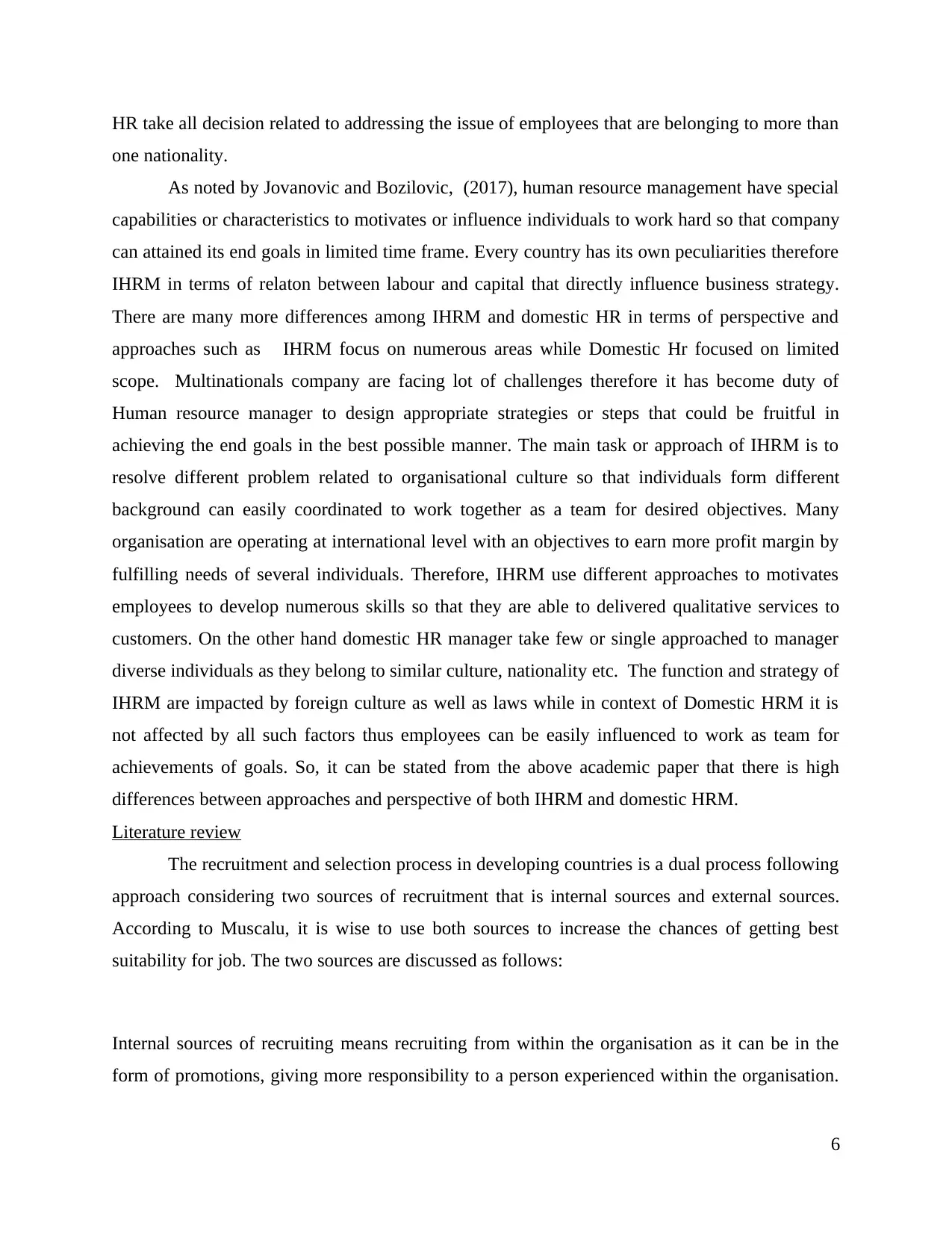
HR take all decision related to addressing the issue of employees that are belonging to more than
one nationality.
As noted by Jovanovic and Bozilovic, (2017), human resource management have special
capabilities or characteristics to motivates or influence individuals to work hard so that company
can attained its end goals in limited time frame. Every country has its own peculiarities therefore
IHRM in terms of relaton between labour and capital that directly influence business strategy.
There are many more differences among IHRM and domestic HR in terms of perspective and
approaches such as IHRM focus on numerous areas while Domestic Hr focused on limited
scope. Multinationals company are facing lot of challenges therefore it has become duty of
Human resource manager to design appropriate strategies or steps that could be fruitful in
achieving the end goals in the best possible manner. The main task or approach of IHRM is to
resolve different problem related to organisational culture so that individuals form different
background can easily coordinated to work together as a team for desired objectives. Many
organisation are operating at international level with an objectives to earn more profit margin by
fulfilling needs of several individuals. Therefore, IHRM use different approaches to motivates
employees to develop numerous skills so that they are able to delivered qualitative services to
customers. On the other hand domestic HR manager take few or single approached to manager
diverse individuals as they belong to similar culture, nationality etc. The function and strategy of
IHRM are impacted by foreign culture as well as laws while in context of Domestic HRM it is
not affected by all such factors thus employees can be easily influenced to work as team for
achievements of goals. So, it can be stated from the above academic paper that there is high
differences between approaches and perspective of both IHRM and domestic HRM.
Literature review
The recruitment and selection process in developing countries is a dual process following
approach considering two sources of recruitment that is internal sources and external sources.
According to Muscalu, it is wise to use both sources to increase the chances of getting best
suitability for job. The two sources are discussed as follows:
Internal sources of recruiting means recruiting from within the organisation as it can be in the
form of promotions, giving more responsibility to a person experienced within the organisation.
6
one nationality.
As noted by Jovanovic and Bozilovic, (2017), human resource management have special
capabilities or characteristics to motivates or influence individuals to work hard so that company
can attained its end goals in limited time frame. Every country has its own peculiarities therefore
IHRM in terms of relaton between labour and capital that directly influence business strategy.
There are many more differences among IHRM and domestic HR in terms of perspective and
approaches such as IHRM focus on numerous areas while Domestic Hr focused on limited
scope. Multinationals company are facing lot of challenges therefore it has become duty of
Human resource manager to design appropriate strategies or steps that could be fruitful in
achieving the end goals in the best possible manner. The main task or approach of IHRM is to
resolve different problem related to organisational culture so that individuals form different
background can easily coordinated to work together as a team for desired objectives. Many
organisation are operating at international level with an objectives to earn more profit margin by
fulfilling needs of several individuals. Therefore, IHRM use different approaches to motivates
employees to develop numerous skills so that they are able to delivered qualitative services to
customers. On the other hand domestic HR manager take few or single approached to manager
diverse individuals as they belong to similar culture, nationality etc. The function and strategy of
IHRM are impacted by foreign culture as well as laws while in context of Domestic HRM it is
not affected by all such factors thus employees can be easily influenced to work as team for
achievements of goals. So, it can be stated from the above academic paper that there is high
differences between approaches and perspective of both IHRM and domestic HRM.
Literature review
The recruitment and selection process in developing countries is a dual process following
approach considering two sources of recruitment that is internal sources and external sources.
According to Muscalu, it is wise to use both sources to increase the chances of getting best
suitability for job. The two sources are discussed as follows:
Internal sources of recruiting means recruiting from within the organisation as it can be in the
form of promotions, giving more responsibility to a person experienced within the organisation.
6
⊘ This is a preview!⊘
Do you want full access?
Subscribe today to unlock all pages.

Trusted by 1+ million students worldwide
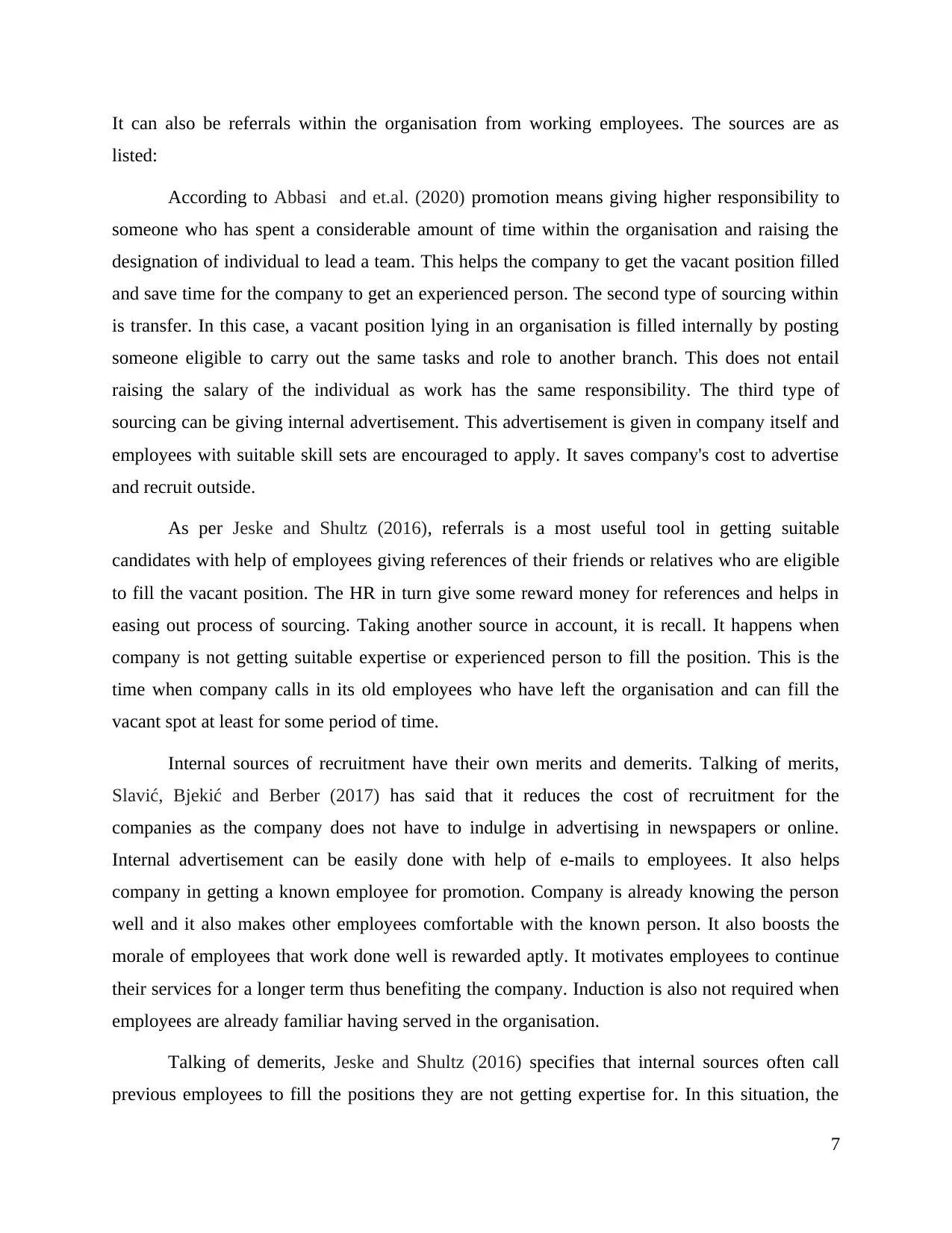
It can also be referrals within the organisation from working employees. The sources are as
listed:
According to Abbasi and et.al. (2020) promotion means giving higher responsibility to
someone who has spent a considerable amount of time within the organisation and raising the
designation of individual to lead a team. This helps the company to get the vacant position filled
and save time for the company to get an experienced person. The second type of sourcing within
is transfer. In this case, a vacant position lying in an organisation is filled internally by posting
someone eligible to carry out the same tasks and role to another branch. This does not entail
raising the salary of the individual as work has the same responsibility. The third type of
sourcing can be giving internal advertisement. This advertisement is given in company itself and
employees with suitable skill sets are encouraged to apply. It saves company's cost to advertise
and recruit outside.
As per Jeske and Shultz (2016), referrals is a most useful tool in getting suitable
candidates with help of employees giving references of their friends or relatives who are eligible
to fill the vacant position. The HR in turn give some reward money for references and helps in
easing out process of sourcing. Taking another source in account, it is recall. It happens when
company is not getting suitable expertise or experienced person to fill the position. This is the
time when company calls in its old employees who have left the organisation and can fill the
vacant spot at least for some period of time.
Internal sources of recruitment have their own merits and demerits. Talking of merits,
Slavić, Bjekić and Berber (2017) has said that it reduces the cost of recruitment for the
companies as the company does not have to indulge in advertising in newspapers or online.
Internal advertisement can be easily done with help of e-mails to employees. It also helps
company in getting a known employee for promotion. Company is already knowing the person
well and it also makes other employees comfortable with the known person. It also boosts the
morale of employees that work done well is rewarded aptly. It motivates employees to continue
their services for a longer term thus benefiting the company. Induction is also not required when
employees are already familiar having served in the organisation.
Talking of demerits, Jeske and Shultz (2016) specifies that internal sources often call
previous employees to fill the positions they are not getting expertise for. In this situation, the
7
listed:
According to Abbasi and et.al. (2020) promotion means giving higher responsibility to
someone who has spent a considerable amount of time within the organisation and raising the
designation of individual to lead a team. This helps the company to get the vacant position filled
and save time for the company to get an experienced person. The second type of sourcing within
is transfer. In this case, a vacant position lying in an organisation is filled internally by posting
someone eligible to carry out the same tasks and role to another branch. This does not entail
raising the salary of the individual as work has the same responsibility. The third type of
sourcing can be giving internal advertisement. This advertisement is given in company itself and
employees with suitable skill sets are encouraged to apply. It saves company's cost to advertise
and recruit outside.
As per Jeske and Shultz (2016), referrals is a most useful tool in getting suitable
candidates with help of employees giving references of their friends or relatives who are eligible
to fill the vacant position. The HR in turn give some reward money for references and helps in
easing out process of sourcing. Taking another source in account, it is recall. It happens when
company is not getting suitable expertise or experienced person to fill the position. This is the
time when company calls in its old employees who have left the organisation and can fill the
vacant spot at least for some period of time.
Internal sources of recruitment have their own merits and demerits. Talking of merits,
Slavić, Bjekić and Berber (2017) has said that it reduces the cost of recruitment for the
companies as the company does not have to indulge in advertising in newspapers or online.
Internal advertisement can be easily done with help of e-mails to employees. It also helps
company in getting a known employee for promotion. Company is already knowing the person
well and it also makes other employees comfortable with the known person. It also boosts the
morale of employees that work done well is rewarded aptly. It motivates employees to continue
their services for a longer term thus benefiting the company. Induction is also not required when
employees are already familiar having served in the organisation.
Talking of demerits, Jeske and Shultz (2016) specifies that internal sources often call
previous employees to fill the positions they are not getting expertise for. In this situation, the
7
Paraphrase This Document
Need a fresh take? Get an instant paraphrase of this document with our AI Paraphraser
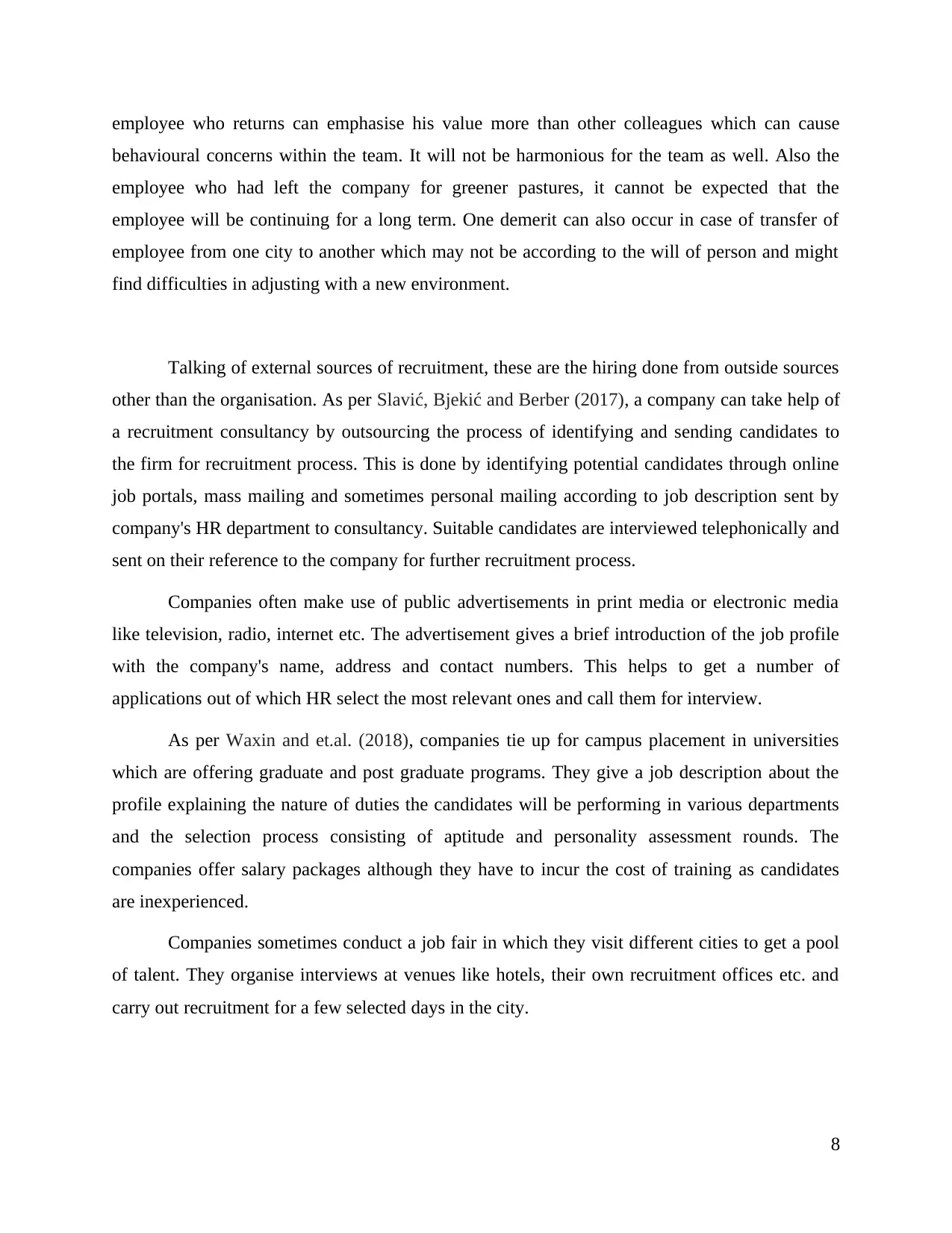
employee who returns can emphasise his value more than other colleagues which can cause
behavioural concerns within the team. It will not be harmonious for the team as well. Also the
employee who had left the company for greener pastures, it cannot be expected that the
employee will be continuing for a long term. One demerit can also occur in case of transfer of
employee from one city to another which may not be according to the will of person and might
find difficulties in adjusting with a new environment.
Talking of external sources of recruitment, these are the hiring done from outside sources
other than the organisation. As per Slavić, Bjekić and Berber (2017), a company can take help of
a recruitment consultancy by outsourcing the process of identifying and sending candidates to
the firm for recruitment process. This is done by identifying potential candidates through online
job portals, mass mailing and sometimes personal mailing according to job description sent by
company's HR department to consultancy. Suitable candidates are interviewed telephonically and
sent on their reference to the company for further recruitment process.
Companies often make use of public advertisements in print media or electronic media
like television, radio, internet etc. The advertisement gives a brief introduction of the job profile
with the company's name, address and contact numbers. This helps to get a number of
applications out of which HR select the most relevant ones and call them for interview.
As per Waxin and et.al. (2018), companies tie up for campus placement in universities
which are offering graduate and post graduate programs. They give a job description about the
profile explaining the nature of duties the candidates will be performing in various departments
and the selection process consisting of aptitude and personality assessment rounds. The
companies offer salary packages although they have to incur the cost of training as candidates
are inexperienced.
Companies sometimes conduct a job fair in which they visit different cities to get a pool
of talent. They organise interviews at venues like hotels, their own recruitment offices etc. and
carry out recruitment for a few selected days in the city.
8
behavioural concerns within the team. It will not be harmonious for the team as well. Also the
employee who had left the company for greener pastures, it cannot be expected that the
employee will be continuing for a long term. One demerit can also occur in case of transfer of
employee from one city to another which may not be according to the will of person and might
find difficulties in adjusting with a new environment.
Talking of external sources of recruitment, these are the hiring done from outside sources
other than the organisation. As per Slavić, Bjekić and Berber (2017), a company can take help of
a recruitment consultancy by outsourcing the process of identifying and sending candidates to
the firm for recruitment process. This is done by identifying potential candidates through online
job portals, mass mailing and sometimes personal mailing according to job description sent by
company's HR department to consultancy. Suitable candidates are interviewed telephonically and
sent on their reference to the company for further recruitment process.
Companies often make use of public advertisements in print media or electronic media
like television, radio, internet etc. The advertisement gives a brief introduction of the job profile
with the company's name, address and contact numbers. This helps to get a number of
applications out of which HR select the most relevant ones and call them for interview.
As per Waxin and et.al. (2018), companies tie up for campus placement in universities
which are offering graduate and post graduate programs. They give a job description about the
profile explaining the nature of duties the candidates will be performing in various departments
and the selection process consisting of aptitude and personality assessment rounds. The
companies offer salary packages although they have to incur the cost of training as candidates
are inexperienced.
Companies sometimes conduct a job fair in which they visit different cities to get a pool
of talent. They organise interviews at venues like hotels, their own recruitment offices etc. and
carry out recruitment for a few selected days in the city.
8
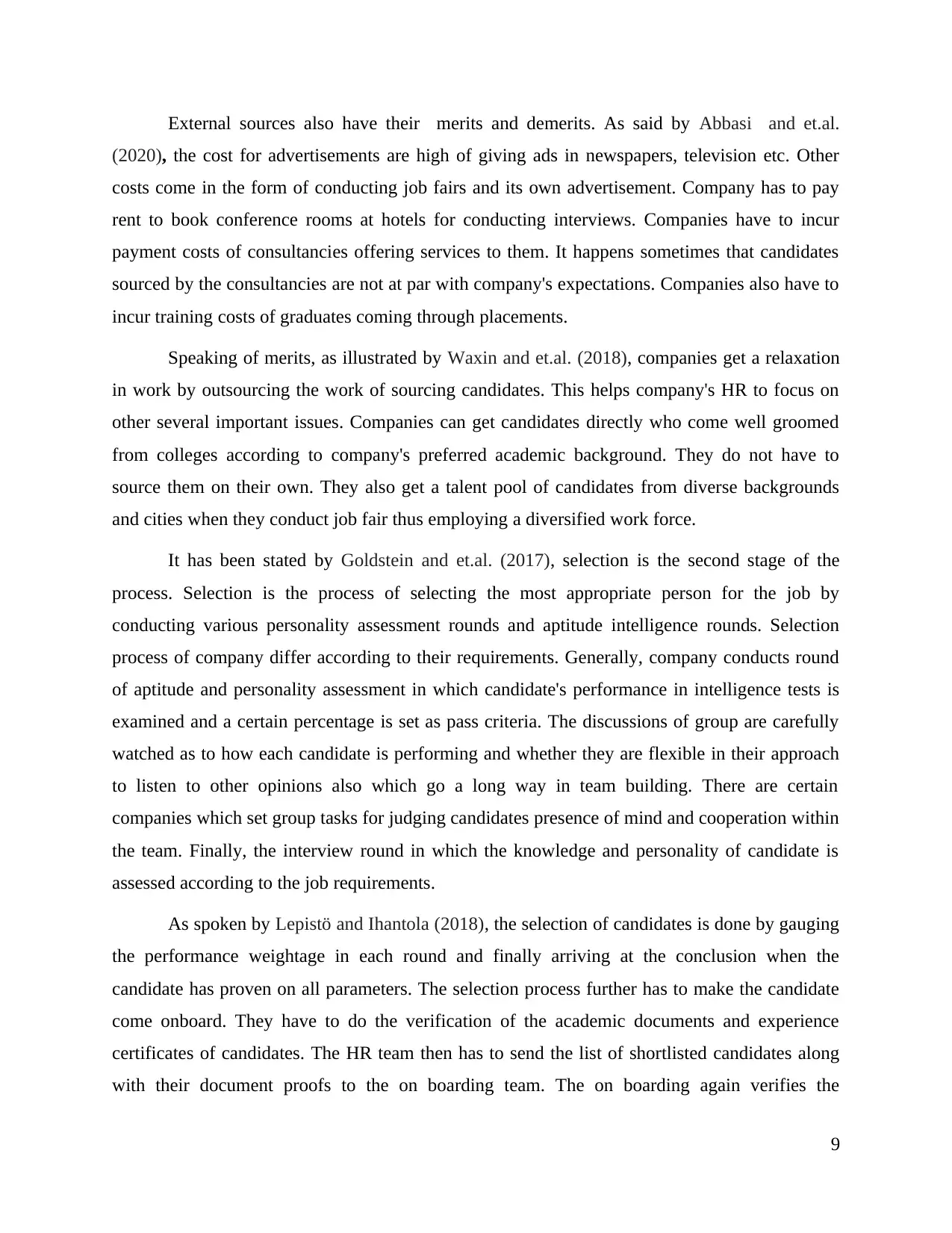
External sources also have their merits and demerits. As said by Abbasi and et.al.
(2020), the cost for advertisements are high of giving ads in newspapers, television etc. Other
costs come in the form of conducting job fairs and its own advertisement. Company has to pay
rent to book conference rooms at hotels for conducting interviews. Companies have to incur
payment costs of consultancies offering services to them. It happens sometimes that candidates
sourced by the consultancies are not at par with company's expectations. Companies also have to
incur training costs of graduates coming through placements.
Speaking of merits, as illustrated by Waxin and et.al. (2018), companies get a relaxation
in work by outsourcing the work of sourcing candidates. This helps company's HR to focus on
other several important issues. Companies can get candidates directly who come well groomed
from colleges according to company's preferred academic background. They do not have to
source them on their own. They also get a talent pool of candidates from diverse backgrounds
and cities when they conduct job fair thus employing a diversified work force.
It has been stated by Goldstein and et.al. (2017), selection is the second stage of the
process. Selection is the process of selecting the most appropriate person for the job by
conducting various personality assessment rounds and aptitude intelligence rounds. Selection
process of company differ according to their requirements. Generally, company conducts round
of aptitude and personality assessment in which candidate's performance in intelligence tests is
examined and a certain percentage is set as pass criteria. The discussions of group are carefully
watched as to how each candidate is performing and whether they are flexible in their approach
to listen to other opinions also which go a long way in team building. There are certain
companies which set group tasks for judging candidates presence of mind and cooperation within
the team. Finally, the interview round in which the knowledge and personality of candidate is
assessed according to the job requirements.
As spoken by Lepistö and Ihantola (2018), the selection of candidates is done by gauging
the performance weightage in each round and finally arriving at the conclusion when the
candidate has proven on all parameters. The selection process further has to make the candidate
come onboard. They have to do the verification of the academic documents and experience
certificates of candidates. The HR team then has to send the list of shortlisted candidates along
with their document proofs to the on boarding team. The on boarding again verifies the
9
(2020), the cost for advertisements are high of giving ads in newspapers, television etc. Other
costs come in the form of conducting job fairs and its own advertisement. Company has to pay
rent to book conference rooms at hotels for conducting interviews. Companies have to incur
payment costs of consultancies offering services to them. It happens sometimes that candidates
sourced by the consultancies are not at par with company's expectations. Companies also have to
incur training costs of graduates coming through placements.
Speaking of merits, as illustrated by Waxin and et.al. (2018), companies get a relaxation
in work by outsourcing the work of sourcing candidates. This helps company's HR to focus on
other several important issues. Companies can get candidates directly who come well groomed
from colleges according to company's preferred academic background. They do not have to
source them on their own. They also get a talent pool of candidates from diverse backgrounds
and cities when they conduct job fair thus employing a diversified work force.
It has been stated by Goldstein and et.al. (2017), selection is the second stage of the
process. Selection is the process of selecting the most appropriate person for the job by
conducting various personality assessment rounds and aptitude intelligence rounds. Selection
process of company differ according to their requirements. Generally, company conducts round
of aptitude and personality assessment in which candidate's performance in intelligence tests is
examined and a certain percentage is set as pass criteria. The discussions of group are carefully
watched as to how each candidate is performing and whether they are flexible in their approach
to listen to other opinions also which go a long way in team building. There are certain
companies which set group tasks for judging candidates presence of mind and cooperation within
the team. Finally, the interview round in which the knowledge and personality of candidate is
assessed according to the job requirements.
As spoken by Lepistö and Ihantola (2018), the selection of candidates is done by gauging
the performance weightage in each round and finally arriving at the conclusion when the
candidate has proven on all parameters. The selection process further has to make the candidate
come onboard. They have to do the verification of the academic documents and experience
certificates of candidates. The HR team then has to send the list of shortlisted candidates along
with their document proofs to the on boarding team. The on boarding again verifies the
9
⊘ This is a preview!⊘
Do you want full access?
Subscribe today to unlock all pages.

Trusted by 1+ million students worldwide
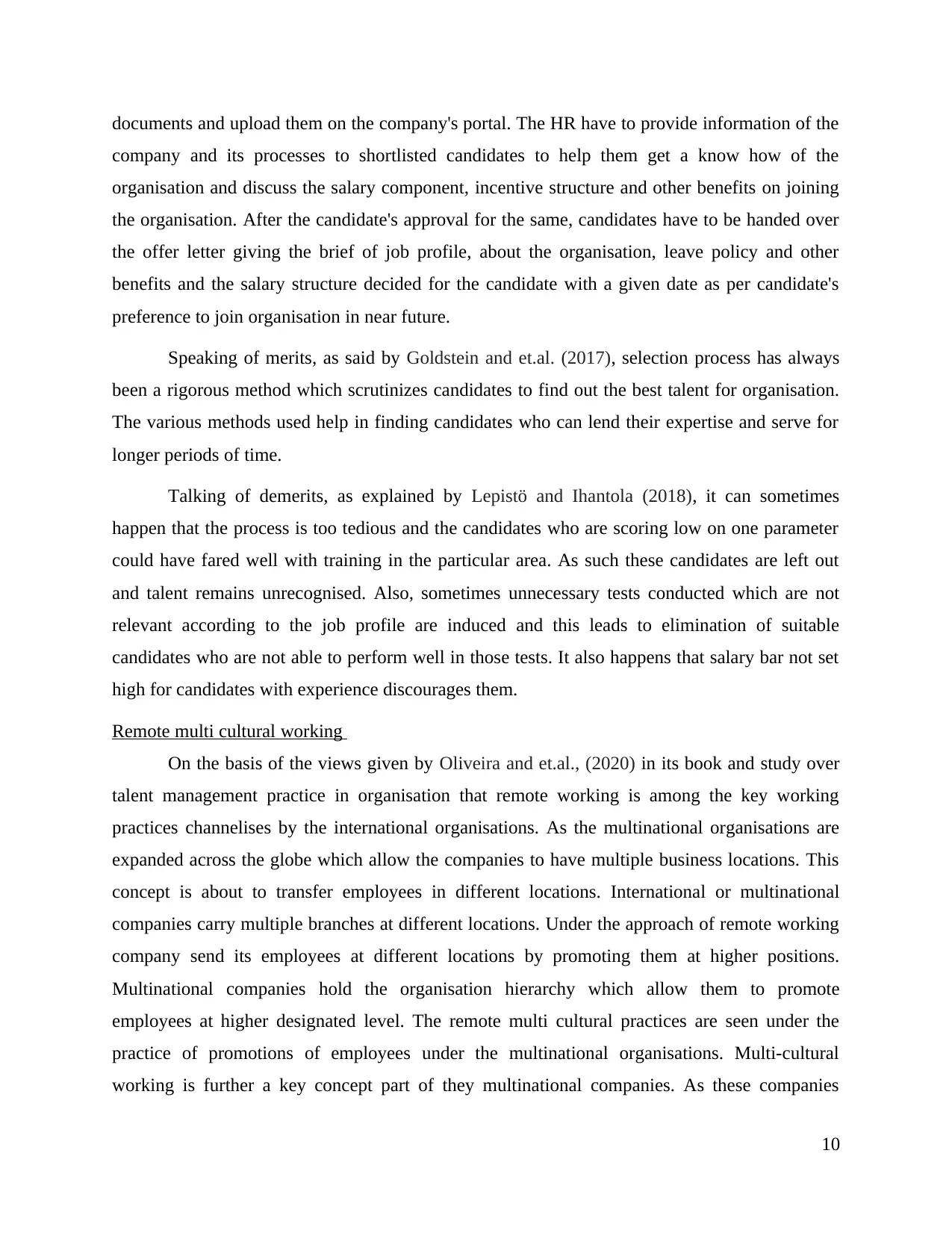
documents and upload them on the company's portal. The HR have to provide information of the
company and its processes to shortlisted candidates to help them get a know how of the
organisation and discuss the salary component, incentive structure and other benefits on joining
the organisation. After the candidate's approval for the same, candidates have to be handed over
the offer letter giving the brief of job profile, about the organisation, leave policy and other
benefits and the salary structure decided for the candidate with a given date as per candidate's
preference to join organisation in near future.
Speaking of merits, as said by Goldstein and et.al. (2017), selection process has always
been a rigorous method which scrutinizes candidates to find out the best talent for organisation.
The various methods used help in finding candidates who can lend their expertise and serve for
longer periods of time.
Talking of demerits, as explained by Lepistö and Ihantola (2018), it can sometimes
happen that the process is too tedious and the candidates who are scoring low on one parameter
could have fared well with training in the particular area. As such these candidates are left out
and talent remains unrecognised. Also, sometimes unnecessary tests conducted which are not
relevant according to the job profile are induced and this leads to elimination of suitable
candidates who are not able to perform well in those tests. It also happens that salary bar not set
high for candidates with experience discourages them.
Remote multi cultural working
On the basis of the views given by Oliveira and et.al., (2020) in its book and study over
talent management practice in organisation that remote working is among the key working
practices channelises by the international organisations. As the multinational organisations are
expanded across the globe which allow the companies to have multiple business locations. This
concept is about to transfer employees in different locations. International or multinational
companies carry multiple branches at different locations. Under the approach of remote working
company send its employees at different locations by promoting them at higher positions.
Multinational companies hold the organisation hierarchy which allow them to promote
employees at higher designated level. The remote multi cultural practices are seen under the
practice of promotions of employees under the multinational organisations. Multi-cultural
working is further a key concept part of they multinational companies. As these companies
10
company and its processes to shortlisted candidates to help them get a know how of the
organisation and discuss the salary component, incentive structure and other benefits on joining
the organisation. After the candidate's approval for the same, candidates have to be handed over
the offer letter giving the brief of job profile, about the organisation, leave policy and other
benefits and the salary structure decided for the candidate with a given date as per candidate's
preference to join organisation in near future.
Speaking of merits, as said by Goldstein and et.al. (2017), selection process has always
been a rigorous method which scrutinizes candidates to find out the best talent for organisation.
The various methods used help in finding candidates who can lend their expertise and serve for
longer periods of time.
Talking of demerits, as explained by Lepistö and Ihantola (2018), it can sometimes
happen that the process is too tedious and the candidates who are scoring low on one parameter
could have fared well with training in the particular area. As such these candidates are left out
and talent remains unrecognised. Also, sometimes unnecessary tests conducted which are not
relevant according to the job profile are induced and this leads to elimination of suitable
candidates who are not able to perform well in those tests. It also happens that salary bar not set
high for candidates with experience discourages them.
Remote multi cultural working
On the basis of the views given by Oliveira and et.al., (2020) in its book and study over
talent management practice in organisation that remote working is among the key working
practices channelises by the international organisations. As the multinational organisations are
expanded across the globe which allow the companies to have multiple business locations. This
concept is about to transfer employees in different locations. International or multinational
companies carry multiple branches at different locations. Under the approach of remote working
company send its employees at different locations by promoting them at higher positions.
Multinational companies hold the organisation hierarchy which allow them to promote
employees at higher designated level. The remote multi cultural practices are seen under the
practice of promotions of employees under the multinational organisations. Multi-cultural
working is further a key concept part of they multinational companies. As these companies
10
Paraphrase This Document
Need a fresh take? Get an instant paraphrase of this document with our AI Paraphraser
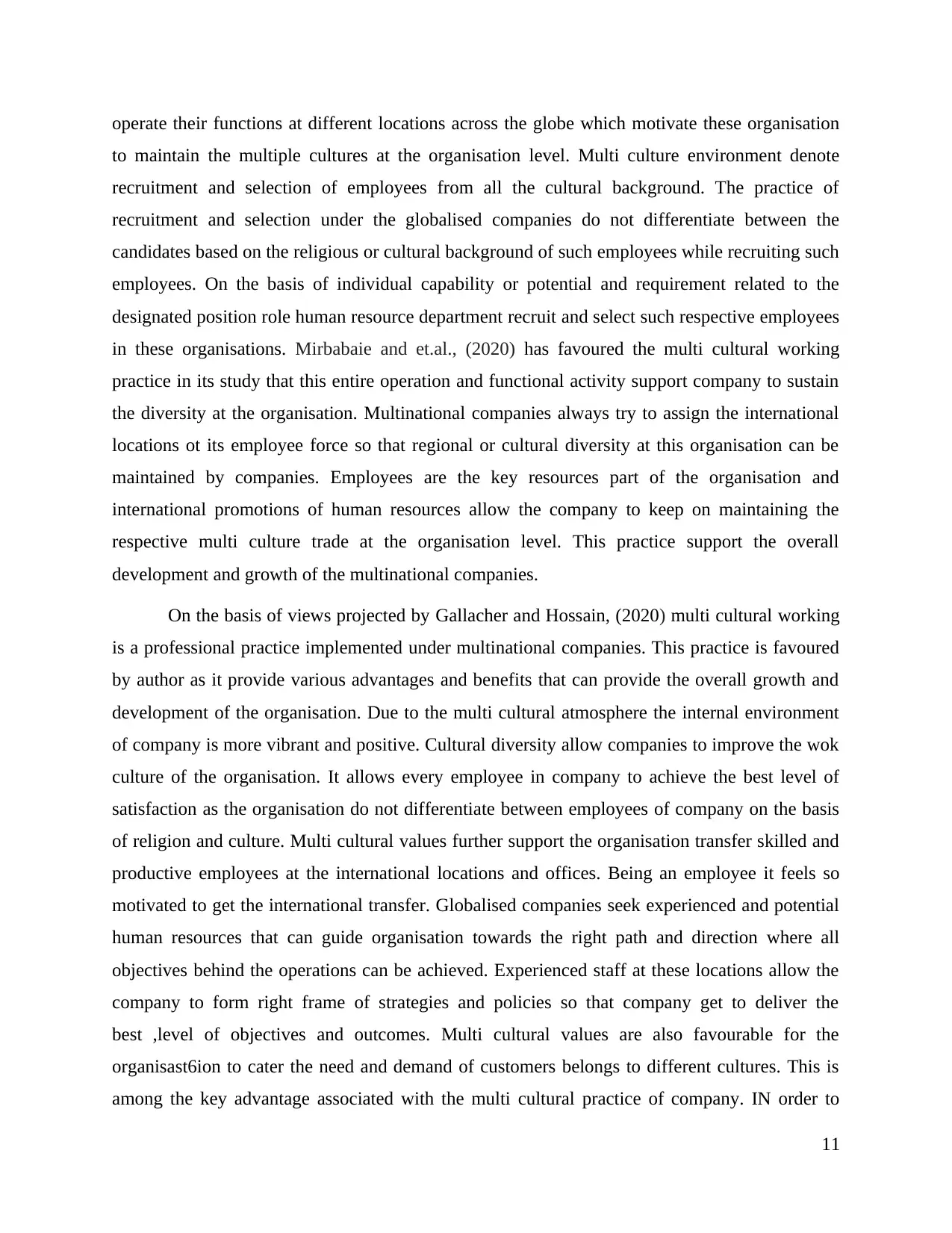
operate their functions at different locations across the globe which motivate these organisation
to maintain the multiple cultures at the organisation level. Multi culture environment denote
recruitment and selection of employees from all the cultural background. The practice of
recruitment and selection under the globalised companies do not differentiate between the
candidates based on the religious or cultural background of such employees while recruiting such
employees. On the basis of individual capability or potential and requirement related to the
designated position role human resource department recruit and select such respective employees
in these organisations. Mirbabaie and et.al., (2020) has favoured the multi cultural working
practice in its study that this entire operation and functional activity support company to sustain
the diversity at the organisation. Multinational companies always try to assign the international
locations ot its employee force so that regional or cultural diversity at this organisation can be
maintained by companies. Employees are the key resources part of the organisation and
international promotions of human resources allow the company to keep on maintaining the
respective multi culture trade at the organisation level. This practice support the overall
development and growth of the multinational companies.
On the basis of views projected by Gallacher and Hossain, (2020) multi cultural working
is a professional practice implemented under multinational companies. This practice is favoured
by author as it provide various advantages and benefits that can provide the overall growth and
development of the organisation. Due to the multi cultural atmosphere the internal environment
of company is more vibrant and positive. Cultural diversity allow companies to improve the wok
culture of the organisation. It allows every employee in company to achieve the best level of
satisfaction as the organisation do not differentiate between employees of company on the basis
of religion and culture. Multi cultural values further support the organisation transfer skilled and
productive employees at the international locations and offices. Being an employee it feels so
motivated to get the international transfer. Globalised companies seek experienced and potential
human resources that can guide organisation towards the right path and direction where all
objectives behind the operations can be achieved. Experienced staff at these locations allow the
company to form right frame of strategies and policies so that company get to deliver the
best ,level of objectives and outcomes. Multi cultural values are also favourable for the
organisast6ion to cater the need and demand of customers belongs to different cultures. This is
among the key advantage associated with the multi cultural practice of company. IN order to
11
to maintain the multiple cultures at the organisation level. Multi culture environment denote
recruitment and selection of employees from all the cultural background. The practice of
recruitment and selection under the globalised companies do not differentiate between the
candidates based on the religious or cultural background of such employees while recruiting such
employees. On the basis of individual capability or potential and requirement related to the
designated position role human resource department recruit and select such respective employees
in these organisations. Mirbabaie and et.al., (2020) has favoured the multi cultural working
practice in its study that this entire operation and functional activity support company to sustain
the diversity at the organisation. Multinational companies always try to assign the international
locations ot its employee force so that regional or cultural diversity at this organisation can be
maintained by companies. Employees are the key resources part of the organisation and
international promotions of human resources allow the company to keep on maintaining the
respective multi culture trade at the organisation level. This practice support the overall
development and growth of the multinational companies.
On the basis of views projected by Gallacher and Hossain, (2020) multi cultural working
is a professional practice implemented under multinational companies. This practice is favoured
by author as it provide various advantages and benefits that can provide the overall growth and
development of the organisation. Due to the multi cultural atmosphere the internal environment
of company is more vibrant and positive. Cultural diversity allow companies to improve the wok
culture of the organisation. It allows every employee in company to achieve the best level of
satisfaction as the organisation do not differentiate between employees of company on the basis
of religion and culture. Multi cultural values further support the organisation transfer skilled and
productive employees at the international locations and offices. Being an employee it feels so
motivated to get the international transfer. Globalised companies seek experienced and potential
human resources that can guide organisation towards the right path and direction where all
objectives behind the operations can be achieved. Experienced staff at these locations allow the
company to form right frame of strategies and policies so that company get to deliver the
best ,level of objectives and outcomes. Multi cultural values are also favourable for the
organisast6ion to cater the need and demand of customers belongs to different cultures. This is
among the key advantage associated with the multi cultural practice of company. IN order to
11
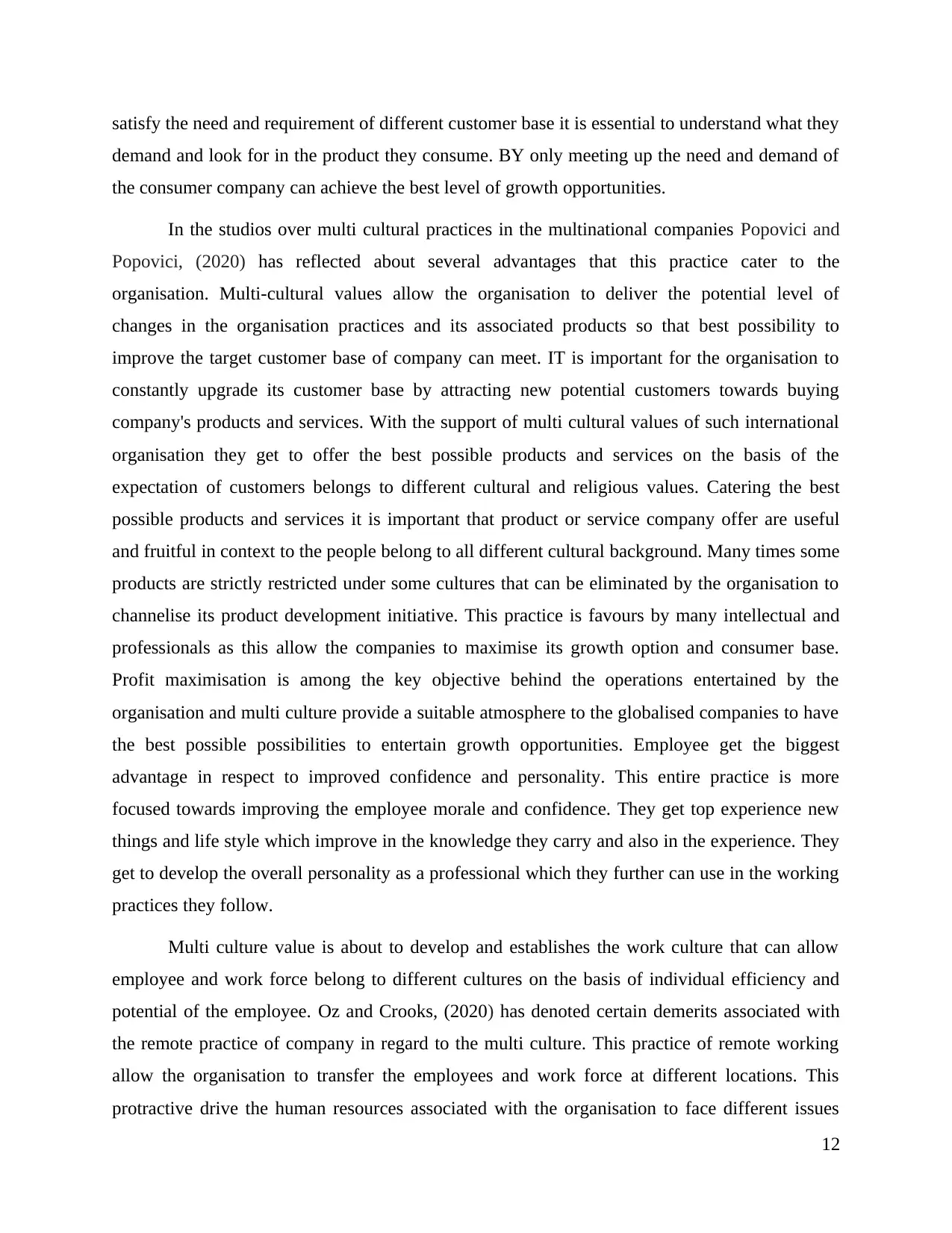
satisfy the need and requirement of different customer base it is essential to understand what they
demand and look for in the product they consume. BY only meeting up the need and demand of
the consumer company can achieve the best level of growth opportunities.
In the studios over multi cultural practices in the multinational companies Popovici and
Popovici, (2020) has reflected about several advantages that this practice cater to the
organisation. Multi-cultural values allow the organisation to deliver the potential level of
changes in the organisation practices and its associated products so that best possibility to
improve the target customer base of company can meet. IT is important for the organisation to
constantly upgrade its customer base by attracting new potential customers towards buying
company's products and services. With the support of multi cultural values of such international
organisation they get to offer the best possible products and services on the basis of the
expectation of customers belongs to different cultural and religious values. Catering the best
possible products and services it is important that product or service company offer are useful
and fruitful in context to the people belong to all different cultural background. Many times some
products are strictly restricted under some cultures that can be eliminated by the organisation to
channelise its product development initiative. This practice is favours by many intellectual and
professionals as this allow the companies to maximise its growth option and consumer base.
Profit maximisation is among the key objective behind the operations entertained by the
organisation and multi culture provide a suitable atmosphere to the globalised companies to have
the best possible possibilities to entertain growth opportunities. Employee get the biggest
advantage in respect to improved confidence and personality. This entire practice is more
focused towards improving the employee morale and confidence. They get top experience new
things and life style which improve in the knowledge they carry and also in the experience. They
get to develop the overall personality as a professional which they further can use in the working
practices they follow.
Multi culture value is about to develop and establishes the work culture that can allow
employee and work force belong to different cultures on the basis of individual efficiency and
potential of the employee. Oz and Crooks, (2020) has denoted certain demerits associated with
the remote practice of company in regard to the multi culture. This practice of remote working
allow the organisation to transfer the employees and work force at different locations. This
protractive drive the human resources associated with the organisation to face different issues
12
demand and look for in the product they consume. BY only meeting up the need and demand of
the consumer company can achieve the best level of growth opportunities.
In the studios over multi cultural practices in the multinational companies Popovici and
Popovici, (2020) has reflected about several advantages that this practice cater to the
organisation. Multi-cultural values allow the organisation to deliver the potential level of
changes in the organisation practices and its associated products so that best possibility to
improve the target customer base of company can meet. IT is important for the organisation to
constantly upgrade its customer base by attracting new potential customers towards buying
company's products and services. With the support of multi cultural values of such international
organisation they get to offer the best possible products and services on the basis of the
expectation of customers belongs to different cultural and religious values. Catering the best
possible products and services it is important that product or service company offer are useful
and fruitful in context to the people belong to all different cultural background. Many times some
products are strictly restricted under some cultures that can be eliminated by the organisation to
channelise its product development initiative. This practice is favours by many intellectual and
professionals as this allow the companies to maximise its growth option and consumer base.
Profit maximisation is among the key objective behind the operations entertained by the
organisation and multi culture provide a suitable atmosphere to the globalised companies to have
the best possible possibilities to entertain growth opportunities. Employee get the biggest
advantage in respect to improved confidence and personality. This entire practice is more
focused towards improving the employee morale and confidence. They get top experience new
things and life style which improve in the knowledge they carry and also in the experience. They
get to develop the overall personality as a professional which they further can use in the working
practices they follow.
Multi culture value is about to develop and establishes the work culture that can allow
employee and work force belong to different cultures on the basis of individual efficiency and
potential of the employee. Oz and Crooks, (2020) has denoted certain demerits associated with
the remote practice of company in regard to the multi culture. This practice of remote working
allow the organisation to transfer the employees and work force at different locations. This
protractive drive the human resources associated with the organisation to face different issues
12
⊘ This is a preview!⊘
Do you want full access?
Subscribe today to unlock all pages.

Trusted by 1+ million students worldwide
1 out of 19
Related Documents
Your All-in-One AI-Powered Toolkit for Academic Success.
+13062052269
info@desklib.com
Available 24*7 on WhatsApp / Email
![[object Object]](/_next/static/media/star-bottom.7253800d.svg)
Unlock your academic potential
Copyright © 2020–2025 A2Z Services. All Rights Reserved. Developed and managed by ZUCOL.





